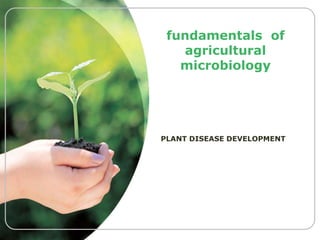
fundamentals of agricultural microbiology.pptx
- 1. fundamentals of agricultural microbiology PLANT DISEASE DEVELOPMENT
- 2. OBJECTIVE Be familiar with disease triangle Clarify the factors for successful disease development Identify stages in disease development
- 3. Outline Disease Triangle Factors for successful disease development 1) Properties of pathogen 2) Properties of host 3) Properties of environment Stages in disease development 1) Inoculation 2) Penetration 3) Infection 4) Growth and Reproduction 5) Dissemination
- 5. Factors for successful disease development
- 6. Disease Triangle Three important components of plant disease : Susceptible host Virulent pathogen Favorable environment For disease to occur all three of these must be present.
- 9. 1) Properties of Pathogen Level of virulence Adaptability Dispersal efficiency Survival efficiency Reproductive fitness
- 10. 2) Properties of Host Susceptibility Growth stage & form Population density & structure General health
- 11. 3) Properties of Environment Temperature Rainfall / Dew Leaf wetness period Soil properties Wind
- 13. Stages in Disease Development 1)Inoculation 2)Penetration 3)Infection 4)Growth and Reproduction 5)Dissemination of Pathogen
- 14. 1) Inoculation Inoculation : The arrival of pathogen on the host Inoculum The pathogen (s) that land on the host or Any part of the pathogen that can initiate infection
- 15. Types of inoculum Primary inoculum An inoculum that survives the dormant period & caused the first infections Primary infections Infection caused by primary inoculum Secondary inoculum An inoculum produced from primary infections Secondary infections Infection caused by secondary inoculum
- 16. Landing or Arrival of inoculum Most is carried by wind, water, insects Only a small number actually lands on susceptible plants Vector born pathogens are much more efficient since the vectors have an attraction for plants E.g: Germination of spores and seeds (fungus) Hatching of nematode eggs Attachment of Pathogen to Host (virus and bacteria) Recognition Between Host and Pathogen (Pathogen recognize the host)
- 17. 2) Penetration The initial invasion of a host by a pathogen: 1. Direct Penetration 2. Penetration Through Natural Openings 3. Penetration Through Wounds
- 18. Direct penetration 1)Direct Penetration Direct with haustoria Direct, subcuticular only Direct intercellular mycellium Direct, intercellular mycellium with haustoria Direct with appressorium (A), penetration peg (PP) and intracellular mycelium (IM)
- 19. Direct penetration The most common type of penetration by fungi and nematodes and the only type by parasitic plants Fungi use a fine hyphae produced by a spore or mycelium or penetration peg produced by an appressorium This is formed at the point of contact with the host
- 20. Direct penetration The penetration is through mechanical force and softening of the cell walls by an enzyme Most fungi form an appressorium at the end of the germ tube Then a penetration peg emerges from the flat surface of the appressorium and pierces the cuticle and cell wall
- 21. Direct penetration The peg grows into a fine hyphae then reaches a normal diameter once it is inside the cell As in the case of apple scab, the fungus penetrates only the cuticle and stays between the cuticle and the cell wall Parasitic plants also penetrate the same way
- 25. Direct, Intercellular Mycelium with Haustoria
- 26. Direct with appressorium (A), penetration peg (PP) & intracellular mycelium (IM)
- 27. 2)Penetration Through Natural Openings Stomata Lenticels (opening on fruits, stems and tubers –filled with loosely connected cells – allow the passage of air) Hydathodes (permanently open pores at the margins and tips of leaves)
- 29. 3) Penetration Through Wounds Through various types of wounds Natural cracks between main and lateral roots Openings made by fungus
- 30. 3) Infection Establishment of pathogen with vulnerable cells or tissues of the host and obtain the nutrients from them Successful infection will produce symptoms
- 31. Incubation period : The time interval between inoculation and the appearance of disease symptoms Latent infection : The state in which a host is infected with a pathogen but does not show any symptoms
- 32. 4) Growth and Reproduction The pathogen will grow and multiply within the infected host. Fungi – spores Viruses – replicated by the cell Nematodes – reproduce by means of eggs 4. GROWTH & REPRODUCTION
- 33. 5) Dissemination of Pathogen Pathogens are disseminated by several ways: By air While airborne – spores touch wet surfaces – get trapped – air movement stops / rains – washed out From the air – brought down by rain drops Winds also helps spreading by blowing away rain splash droplets containing pathogens
- 34. By water Pathogens in the soil – dissemination by rain / irrigation water that moves on the surface / through soil By Insects, Nematodes & other Vectors Transmitted by insects during feeding, movement from plant to plant Nematodes can also transmit virus internally
- 35. By Seed and Transplanting process Transported to other fields Are sold and transported to other areas By human Through handling of diseased and healthy plants Tools (pruning shears) Transporting contaminated soil on their feet / equipment Contaminated container Using infected seed / nursery stock
